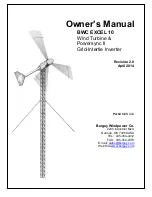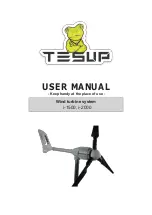
AIR 40, AIR Breeze, AIR 30, AIR X MARINE and AIR SILENT-X are trademarks of Primus Wind Power 2013 Primus Wind Power Inc.
AIR Owner’s Manual
3-CMLT-2020-A
33
The turbine’s internal voltage regulator cannot be completely
turned off. However, by setting the voltage regulation set-point to
its highest value the internal regulator is virtually nullified. If an
external charge controller is utilized, it must be a diversion style
regulator which diverts the excess power to a resistive load.
IMPORTANT: Do not use a pulse width modulated (PWM), maxi-
mum power point tracking (MPPT) or shunt style controller (other
than as diversion load controller). The AIR wind turbine is not de-
signed to work with these types of controllers where the controller
is wired between the wind turbine and the battery bank. Addition-
ally, most controllers designed to work with solar panels are not
suitable for use with the AIR wind turbine. These controllers
“disconnect” the solar panels – or in this case the AIR - from the
battery bank when the batteries are charged, allowing the turbine
to spin free, which is not recommended.
AIR Wind Turbine Maintenance
Although your AIR has been designed to run for long periods with minimal mainte-
nance, moving parts must be maintained to ensure maximum performance and
reliability. As part of complying with the conditions of the Limited Five Year War-
ranty, please adhere to the below.
After one month and every six months thereafter:
•
Check blades for chips or nicks. Replace blades if damaged. Do not operate the
turbine with chipped or unbalanced blades. This will cause severe wear, dam-
age and possible failure. Operating the wind turbine with unbalanced blades
may void your warranty. Do not install individual blades as they are balanced
as a set.
•
Check blade bolts and hub nut for proper tightness. Refer to installation sec-
tion for proper specifications.
•
Check nosecone for any cracks and proper fit.
•
Wash off any built-up dirt or debris from the blades for optimal performance.
•
Check all electrical connections to make sure they are tight and free from
corrosion.
•
Check to see that your tower is plumb. A leaning tower will decrease energy
production.
Every five years:
•
Replace the blades regardless of their condition. The blades contain UV inhibi-
tors; however, the sun will eventually erode the composite material. New
blades enhance safety and performance.
Every seven years:
•
Replace the circuit board. Some components on the PCB require periodic re-
placement due to stress from temperature and voltage fluctuations seen under
normal operating conditions
•
While changing the circuit board, check the condition of the brushes and slip
rings. With the turbine open and the yaw shaft removed, observe the brushes
and slip rings for grooving or other signs of wear.
CAUTION:
Always implement proper storage procedure
when storing your turbine without hub and nose cone in
place. Removing these during storage can allow for water
ingress to occur. See FAQ section on storage kit recommen-
dations and Appendix C
CAUTION:
Never approach the turbine during operation.
WARNING:
Nylock nuts and greased blade bolts may only
be used one time; replace after each use
































